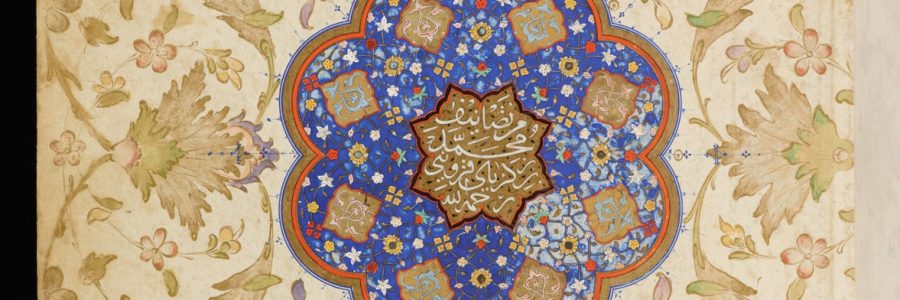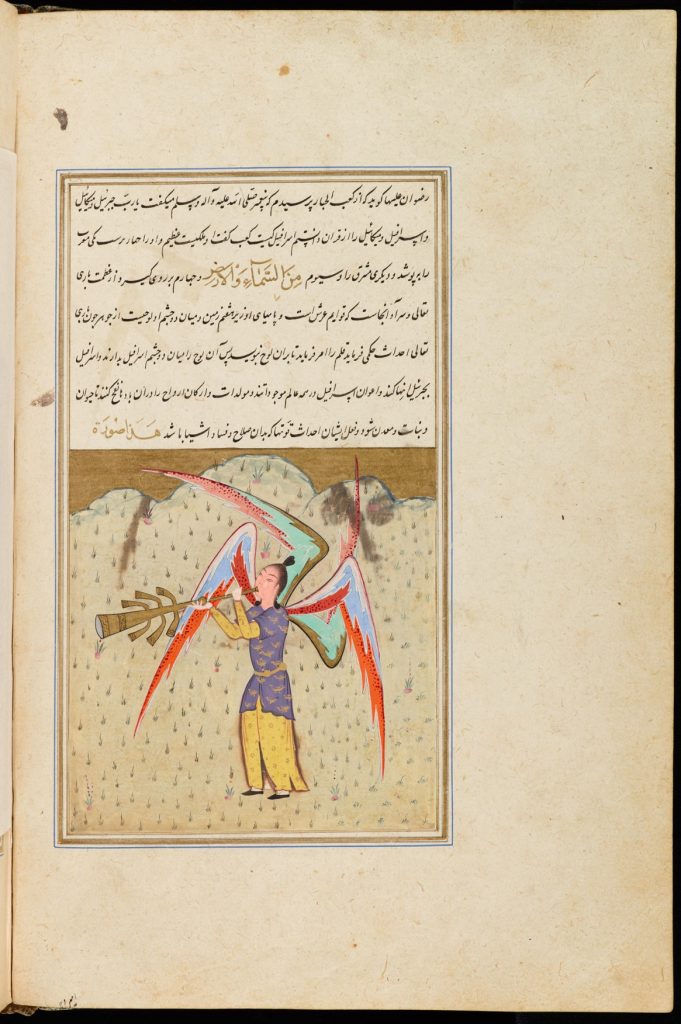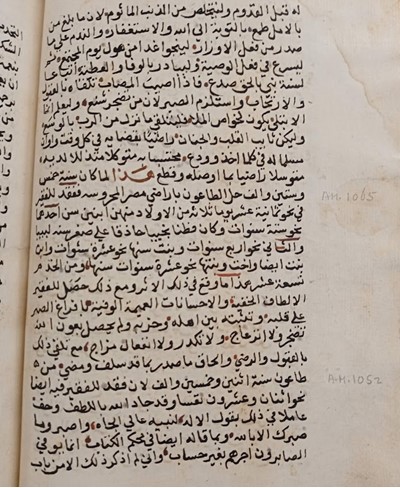
Grief in a Time of Plague: Scripture and Therapeutics in Seventeenth-Century Cairo
This post is by the inaugural Oschinsky Research Associate, Dr James White. James is working with a core group of forty Arabic and Persian manuscripts which date from the thirteenth century through to the sixteenth century, held in the University Library and the Cambridge colleges and museums. The aim of his research is to map the intertextual connections (i.e. instances of text reuse) between these manuscripts, and show how communities of authors, scribes and readers active across North Africa, the Middle East and South Asia were connected through circulation prior to the nineteenth century.
Most readers will associate the plague with the Black Death, which ravaged Eurasia in the mid-fourteenth century. Having spread from Inner Asia, possibly aided by the transregional conquests of the Mongols, the Black Death arrived in the Mediterranean in 1347, and swiftly began to decimate the populations of major cities such as Alexandria.[i] Between a third and a half of the population of the Middle East is thought to have succumbed to the plague in the following years.[ii] Society was devastated – economically, politically, emotionally – in ways which are hard to comprehend, even with our own, contemporary experiences of a pandemic.

In the decades and centuries that followed, the plague did not disappear from the Middle East. Outbreaks recurred frequently between the late fourteenth century and the nineteenth century, the disease sometimes remaining in abeyance for numerous years, and sometimes hitting several times in short succession.[iii] Curiously, even though fear of the plague’s reappearance must have loomed large in the minds of many late medieval and early modern writers, and even though anxieties about it must have tinged everyday experiences, it did not become one of the great, explicitly articulated themes of premodern Arabic text production. In my own field of literary history, I am hard pressed to think of an Arabic work which meditates on love, the body and piety in a plague-riven society in the same way as Boccaccio’s Decameron. An exception, and certainly a very different work from the Decameron, is Badhl al-māʿūn fī faḍl al-ṭāʿūn, by the Egyptian scholar, judge and historian Ibn Ḥajar al-ʿAsqalānī (d. 1449), which has recently been edited and translated into English by Joel Blecher and Mairaj Syed, under the title of Merits of the Plague.[iv] This is a fascinating treatise on pathology, contagion and the responsibilities of the individual, written by a man who lived through three separate major bouts of the plague in the early fifteenth century.[v]
An Arabic manuscript in Cambridge University Library contains another unpublished, and as far as I am aware, unstudied text, which also gives us an insight into how people in the premodern Middle East confronted pandemics, dealt with loss and suffering, and found the resources to continue. The work in question survives in MS Qq. 239, and is entitled Ḥadāʾiq al-ʿuyūn al-bāṣira fī akhbār aḥwāl al-ṭāʿūn wa-al-ākhira (The Pupils of Eyes Looking into Reports on the State of the Plague and the Hereafter).[vi] Ḥadāʾiq al-ʿuyūn was composed in 1661 by Ibrāhīm b. Abī Bakr al-Ṣāliḥī al-ʿAwfī, who tells us in the text itself that he was from Cairo. Al-ʿAwfī also wrote another work, a chronicle of Egypt and its political factionalism in his own time, entitled Tarājim al-ṣawāʿiq fī wāqiʿat al-ṣanājiq (Interpretations of the Thunderbolts [That Struck] in the Battle for the Provinces).[vii] He is sometimes thought to be the same Ibrāhīm b. Abī Bakr al-ʿAwfī as the religious scholar who trained at the Azhar, Cairo’s great centre of Islamic learning, and who died in 1094/1683.[viii]

Ḥadāʾiq al-ʿuyūn is distinguished from Ibn Ḥajar’s Merits of the Plague in several interesting ways, even though internal evidence shows that al-ʿAwfī made extensive use of the Merits, recycling passages from the medieval text. What I find particularly surprising – and moving – about al-ʿAwfī’s book is his discussion of the circumstances in which it was composed. In his introduction, he writes that the plague came to Egypt in the year 1065/1654-55. During the course of eighteen days, he lost three of his children: a son of nearly six – “bright, noble, skilled, despite his young age, and intelligent” – a smaller son of almost four, and a daughter of ten. He also lost one of his grandchildren, a sister, and a young niece. Over the course of the following weeks, nineteen of his servants died. Yet, al-ʿAwfī had trained himself for loss: in the previous epidemic of 1052/1642-43, twenty-two of his friends and family had perished.
What is to be done when so many loved ones die in such quick succession? Al-ʿAwfī’s immediate answer is to be forbearing, and to trust in divine providence, for God “only grants a reward without limit to those who endure” (Q 39:10). Since fortitude in the face of worldly suffering is itself an act of piety, al-ʿAwfī argues that reading, and reading scripture in particular, consoles us with the knowledge of a blissful hereafter, and hence alleviates our present pain. This is the starting point for his inquiry into the plague as a phenomenon that links the physical world with the theological, the metaphysical and the moral. The following chapters use scriptural evidence to treat topics such as how the plague can possibly be a chastisement from God when it afflicts children and the pious. Are there, al-ʿAwfī asks – engaging with Ibn Ḥajar’s thesis – any grounds on which it can be considered a sign of divine clemency? Following Ibn Ḥajar, al-ʿAwfī contends that the plague is spread by the jinn (unseen beings formed from smokeless flame), who infect unsuspecting humans by stinging them.[ix] Yet theoretical issues need to be accounted for: do the Muslim jinn sting humans too, or is it just unbelieving jinn who infect people? Do the jinn consciously intend to sting people, or does contagion occur through happenstance? How is it that people can contract the plague in the month of Ramadan, when the jinn are bound and fettered? If the plague can be construed as a sign of divine clemency, why does it rarely visit the holy cities of Mecca and Medina?
For present-day readers, al-ʿAwfī’s concerns may seem puzzling, but his book is a conscious foray into therapeutics, taking feelings of unfathomable loss and using intellectual curiosity to control and direct them. It is not coincidental that Ḥadāʾiq al-ʿuyūn begins with an inquiry into disaster (al-muṣība), before discussing forbearance (al-ṣabr) and adducing lines of poetry which praise the patient: al-ʿAwfī is trying to take the recently bereaved on a journey to recovery. Unliked many other medieval and early modern writers, who often cultivated a professional persona in their writing, sometimes obscuring their emotional lives, al-ʿAwfī’s book offers a window onto how people in the early modern world approached and accepted loss.

[i] Stuart Borsch, “Black Death”, in: Encyclopaedia of Islam, THREE, eds. Kate Fleet, Gudrun Krämer, Denis Matringe, John Nawas, Devin J. Stewart <http://dx.doi.org//10.1163/1573-3912_ei3_COM_25361>.
[ii] Ibid.
[iii] See B. Shoshan and D. Panzac, “Wabāʾ”, in: Encyclopaedia of Islam, Second Edition, eds. P. Bearman, Th. Bianquis, C.E. Bosworth, E. van Donzel, W.P. Heinrichs < http://dx.doi.org//10.1163/1573-3912_islam_COM_1320>; Justin Stearns, Infectious Ideas: Contagion in Premodern Islamic and Christian Thought in the Western Mediterranean. (Baltimore, 2011), pp. 1-2.
[iv] Ibn Ḥajar al-ʿAsqalānī, Merits of the Plague, ed. and trans. Joel Blecher and Mairaj Syed (New York, 2023).
[v] Ibn Ḥajar al-ʿAsqalānī, Merits of the Plague, pp. xvi-xxi.
[vi] Ḥadāʾiq should strictly mean ‘gardens’; the plural of ḥadaqa, the pupil of the eye, can be ḥadaq, ḥidāq, or aḥdāq. However, the context of the title, on the theme of eyes and sight, suggests that ‘pupils’ is the logical, if ungrammatical, meaning which is intended here.
[vii] ʿAwfī, Ibrāhīm Ibn Abī Bakr, Tarājim al-ṣawāʿiq fī wāqiʿat al-ṣanājiq (Cairo, 1986). See also Carl Brockelmann, History of the Arabic Written Tradition: Supplement Volume Two, trans. J. Lameer (Leiden, 2018), 425.
[viii] See al-Muḥibbī, Khulāṣat al-athar (Beirut, 1967)1, 9-10; al-ʿAwfī, Bughyat al-mutatabbiʿ li-ḥall alfāẓ rawḍ al-murbiʿ (Doha, 2008), 32.
[ix] Ibn Ḥajar al-ʿAsqalānī, Merits of the Plague, p. 37.
